Your Genesys Blog Subscription has been confirmed!
Please add genesys@email.genesys.com to your safe sender list to ensure you receive the weekly blog notifications.
Subscribe to our free newsletter and get blog updates in your inbox
Don't Show This Again.

The goal of customer journey orchestration is to improve journey outcomes by enabling the most relevant interactions in the context of each customer’s goals and their overall experience. Customer journey orchestration enables enterprises to engage prospects and customers at optimal points along their journeys, in real time and through the most effective channels.
Many CX, marketing and operations leaders ask how they can use customer journey orchestration to deliver better, more personalised experiences that will improve CX and business outcomes. In this post, I’ll discuss how organisations are using customer journey orchestration to improve personalisation decisions across all channels and touchpoints, enhance CX and achieve their business goals.
Customer journey orchestration is an approach used by customer-centric enterprises to improve journey outcomes in real time by taking the most relevant interactions in the context of each customer’s goals and their overall experience.
Journey orchestration goes beyond traditional personalisation techniques. It leverages customer journey data from every channel, source or system. This way, each interaction reflects your customer’s entire experience with your organisation — not just the current interaction. As a result, every moment of engagement is highly personalised for each individual, because the interactions a company takes are based on each customer’s prior experience.
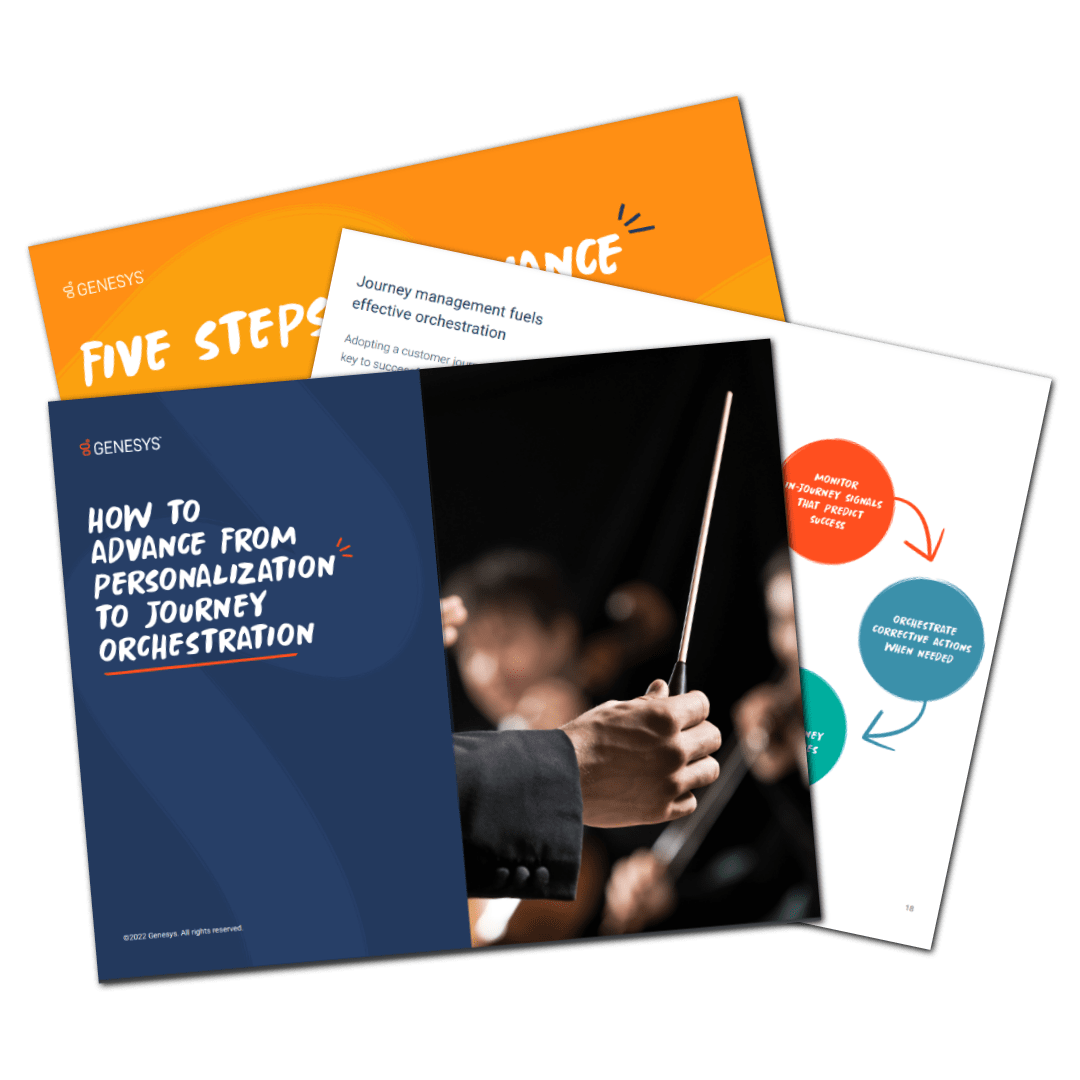
This ebook explores what journey orchestration is, how it’s different from other approaches and five ways to get started.
Ultimately, there are three major beneficiaries for customer journey orchestration:
First and foremost, successful journey orchestration helps your customers reach their goals. By recognising each customer’s journey context, enterprise teams can ensure that every interaction helps a customer progress towards their goals.
Combining orchestration with an approach like customer journey analytics enables journey optimisation, a process that leverages AI and machine learning to improve customer experiences, so they can achieve their goals more efficiently. More importantly, customer journey analytics enables CX, marketing and customer care teams to prioritise CX improvement initiatives and quantify the ROI of CX investments.
Similarly, journey and experience designers can couple journey mapping with customer journey orchestration to execute, monitor and measure the impact of specific design changes and overall experience improvements.
Effective journey orchestration also impacts key business outcomes, such as retention and revenue. Ernst & Young reports that 40% of customers say they would be more likely to stay with their financial services provider if it offered more personalised service. Additionally, the services firm states that “for every $100 billion in assets that a bank has, it can achieve as much as $300 million in revenue growth by personalising its customer interactions.”
Use Case: How a Mortgage Provider Improved CX Using Journey Orchestration
While monitoring the health of top-level journeys across the consumer lending portfolio using the customer journey analytics, executives at a leading financial institution notice that mortgage journey costs are increasing, but self-service percentages are down. The CX team investigates the underlying journeys and identifies that the issue lies within the mortgage refinancing journey. Costs have doubled for this journey, as first call resolution (FCR) has fallen from 65% to 30% and call volume has increased significantly.
The team turns to Pointillist AI to find the root cause of the problem. Pointillist AI quickly reveals that the likelihood of a customer calling an agent is much higher if they were trying to upload their documents using the iOS version of the company’s mobile app.
The CX team notifies IT about the problem, so they can fix the app. In the meantime, they use Pointillist’s journey orchestration capability to activate an audience, which will update daily until the app is fixed. The audience includes customers who have already encountered the problem, as well as customers already in the refinance journey that are likely to experience this issue in the near future. Finally, they work with customer marketing to set up an automated communication to this audience that acknowledges the issue and contains a workaround.
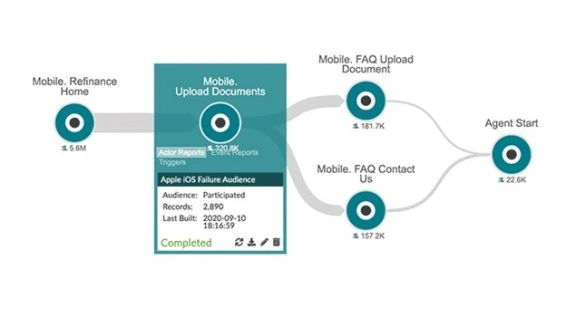
Using Pointillist, the journey owner is able to measure success by an increase in the completion rate of the mobile refinancing journey and a significant decrease in leakage into the contact center from this journey.
While customer journey orchestration might sound familiar, it’s important to distinguish between it and other approaches that sound similar. These approaches may already exist or other may push them as an alternative to attain your organisation’s elusive personalisation goal.
Some of the approaches often confused with customer journey orchestration include:
Marketing campaigns are typically based on customer behaviour from one or a limited number of channels. This is often the case because marketing campaign management systems typically contain data from the limited set of customer interactions that marketing controls, primarily web and email. This subset of the customer experience is not sufficient to enable journey orchestration, because customer journeys are not constrained by marketing channels.
Campaign automation enables a marketer to efficiently define, execute and analyse dozens or hundreds of campaigns. For example, a marketer might send a message to a customer’s phone that links to a landing page. The content on the page is based on which products that customer has. After submitting the form, the system automatically sends an email with content based on the action taken. Finally, the marketer analyses click-through rates and conversions.
In contrast, journey orchestration emanates from the customer. The context is centered on their current goal, which is represented by the journeys they are on, and comprises the entirety of their experience with the company.
Take, for example, a customer desiring to move money from one account to another via their mobile phone. They encounter a problem completing the transaction and turn to the website first and then call the care center for support. After getting lost in the interactive voice response (IVR) system, they go back to the website and try the chat feature. The chat platform queries the journey orchestration platform, where it determines that they are a high-value customer in a money transfer journey who has already interacted with the website and IVR system within the past hour, so it bypasses the chat robot and routes them directly to a high-priority agent, who can assist them along with information that will avoid the customer having to re-explain the entire series of events to the agent.
In essence, campaign management is focused on automating the next action within a series of steps defined by marketers. While campaign management puts your customers into the context of marketer-defined campaigns, customer journey orchestration puts all the resources of your customer into the context of your customer’s individual experience. Marketers cannot dictate a customer’s experience; your customers engage with your business in their own way to achieve their unique goals. The experience is directed by your customer, at their own pace and through the channels they select. Journey orchestration incorporates the full understanding and context of a customer’s experience at every interaction — whether it is instigated by your customer or your company.
Real-time interaction management (RTIM) is a capability that B2C marketers use to help brands deliver more contextually relevant experiences. According to Forrester, “RTIM aligns outbound marketing campaigns with inbound, customer-initiated interactions to ensure relevance.”
A common RTIM use case is the dynamic updating of offers on a website. For example, a telecommunications provider might promote new mobile phones for a customer who is due for an upgrade. Let’s say the customer purchases a new phone and the company’s offer changes to promote phone accessories. However, the customer never activates their new device. Clearly there is an issue. However, the company doesn’t recognise it because they are focused on the customer’s current interaction, rather than the larger journey or her overall experience.
In contrast, organisations that use a journey-based approach can take a much more comprehensive set of behaviours into account, including inaction in a parallel Device Activation Journey. They orchestrate actions that help the customer achieve their overall goal (activating their new device) instead of annoying them by myopically pursuing the marketer’s goal on a particular web page (completing another upsell).
As with campaign automation, RTIM often falls short for the customer. It’s more focused on improving the marketer’s effectiveness than improving the customer’s experience. While RTIM focuses on the importance of context, the context employed is typically limited to current and recent transactions, rather than a customer’s overall experience with the company.
Many chief financial officers, CIOs, digital officers and operations analysts rely on process mining to document, analyse and improve the efficiency of business workflows. Process mining provides analysts and managers with an easy way to analyse event logs within enterprise transaction systems.
Process mining measures the efficiency of a wide variety of business processes, particularly digital processes, from start to finish. Some examples include:
Unlike processes, customer journeys do not conform to a pre-planned sequence. Process mining captures neither individual customer behaviour, nor the range and variety of customer journeys across touchpoints and time. Therefore, process mining cannot orchestrate actions based on a customer’s comprehensive experience with your enterprise, regardless of whether you couple it with workflow automation to enable action.
Process mining focuses on the process, rather than the customer. It focuses on making the process analyst’s life easier by identifying inefficiencies in the process, rather than helping improve the overall customer experience by identifying impediments that block customers from reaching their goals. The customer is not the focus in the world of process mining and it lacks concepts such as behavioural segmentation or audience activation.
Nevertheless, processes within journeys should be measured and improved, such as the steps required to submit a payment through the website or for the company to process and deliver a product. But personalisation is about more than simply improving the efficiency of a predetermined sequence of steps. It’s about ensuring that every moment of your customer’s experience is relevant and cohesive.
In short, process mining can optimise aspects of CX, but it’s not the comprehensive approach required to deliver personalised, consistent experiences to each customer based on the context provided by their unique experience with your company.
Customer expectations for personalisation have evolved immensely. Behemoths like Amazon and Netflix have transformed consumer expectations and influenced the experiences consumers demand from their banks, cable and wireless companies, and even health insurers.
Unfortunately, many enterprises under deliver.
Since sales, marketing, customer service, operations and billing all engage directly with customers, many organisations can’t integrate data across business functions and touchpoints. This often results in irrelevant and inconsistent customer experiences.
CX professionals often state that delivering consistent, exceptional experiences across channels and delivering personalisation at scale are the #4 and #5 overall CX challenges they face today.
Customers want every service interaction to be tailored to not only their persona, but their individual preferences, history and current needs. But as Forrester notes, customer-facing employees typically “lack customer context and cannot access the right knowledge and data” to do so.
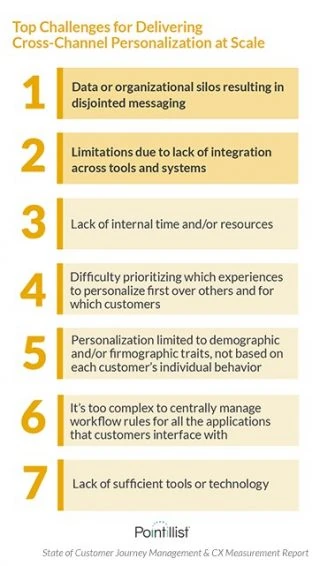
Data and organisational silos are the primary culprit when it comes to orchestrating personalised actions for each customer at scale. Too often, personalisation decisions are based on limited information because integrating customer journey data from each database, system or touchpoint is complex and time consuming.
Indeed, traditional approaches to personalisation often require managing complex personalisation logic across multiple systems. The amount of time and effort necessary to maintain rule-based workflows is excessive and ultimately, ineffective. These workflows usually do not take other concurrent journeys into account. As a result, the interactions customers have across channels do not reflect their current context.
Here are the key steps you need to take to advance your organisation from simple and ineffective personalisation to customer journey orchestration.
It’s just a fact that sales, marketing, customer care, operations, billing and other functions all engage directly with the customer. So in a typical enterprise, customer-facing teams individually develop a variety of systems over time to interact with and gather data on customers. So, how can you orchestrate the optimal experience when each touchpoint they manage already has embedded personalisation logic?
There are two predominant approaches to journey orchestration: centralised and federated. The centralised approach embodied by most traditional personalisation and orchestration solutions puts all the responsibility in one place. It focuses on creating and maintaining a complex set of workflow rules governing every interaction across all touchpoints across the organisation. This approach may appear prudent from a governance standpoint. But, in practice it simply creates a bottleneck by taking control out of the hands of those employees tasked with managing the experience.
On the other hand, a federated approach distributes personalisation logic out to the touchpoints. Rather than centrally defining and controlling every interaction with millions of customers across a sprawling enterprise, a federated approach coordinates and optimises the experience across every touchpoint. Instead of creating a complex bottleneck, a federated approach enables customer facing teams to move forward in a coordinated fashion and at their own pace.
Getting personalisation right pays dividends. Enterprises need an approach that enables them to interact with customers based on their unique journey context, not just their most recent interaction in a siloed touchpoint. Journey orchestration is most successful when embedded within a comprehensive customer journey management approach, which enables teams across your organisation to improve CX and business outcomes simultaneously.
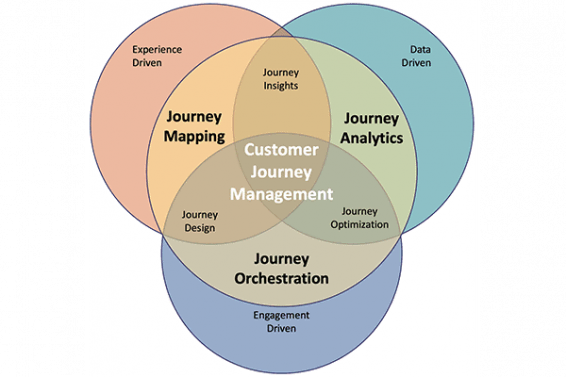
As CX teams identify points of failure in high-impact journeys, they typically collaborate with marketing, experience design, customer care and product teams. These collaborations aim to improve journey performance by addressing or eliminating points of failure and improving the overall experience.
Effective journey management aligns each of your internal teams around customer experience and provides the foundation for successful journey orchestration.
Adopting a customer journey management approach is key to successful journey orchestration. A journey management program will enable you to:
In this way, organisations can orchestrate actions based on each customer’s overall experience.
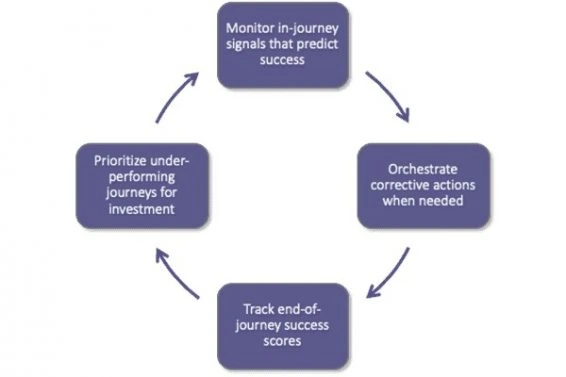
Integrating data across sources and systems to build accessible, persistent profiles is crucial for effective customer journey orchestration. Leveraging customer journey data across channels and time provides you with the context you need to determine the actions most relevant for each customer.
The key to graduating to the next level of personalisation is aligning your enterprise on a journey-based approach and harnessing the capabilities necessary to determine the best action to take with each customer. The next step is to select an orchestration approach that makes sense for the journey you’re focusing on.
As discussed earlier, the key benefit of journey orchestration is to improve personalisation decisions by bringing the full context of each customer’s holistic experience to every interaction. So, use an API-based approach to improve real-time interactions at individual touchpoints by bringing each customer’s overall experience right to the point of interaction. In this way, enterprises can find out, for example, what actions an inbound caller has already taken in order to send them to the IVR or a specific support team.
Sometimes it makes more sense to reach out and communicate with a customer or group of customers at a specific point in a journey. In cases when it’s better to push out communications, use an audience-based orchestration approach.
An audience-based orchestration approach allows teams that engage directly with customers to activate and update audiences based on customer behaviour, either on-demand or at a specified frequency. For example, a marketing team might activate an audience of customers that is about to receive a paper bill via email, web pop-ups, digital ads or even outbound calls.
Traditionally, personalisation at each touchpoint falls under the purview of the touchpoint owner. So, the marketing team manages complex personalisation logic within marketing engagement systems, like email, advertising and the company website. The customer care team oversees the contact center, IVR, chat and other customer service channels.
For example, sending an upsell email may be considered the best action for telecom customers who have visited the website or searched the mobile app for bandwidth or package upgrades. Their goal is to expand their service. However, for customers in the middle of a support journey, their primary goal is to resolve their current issue. Receiving an upsell email that clearly does not recognise their current support journey can lead to resentment and dissatisfaction.
On the other hand, a journey orchestration approach would recognise that the customer is in a support journey and suppress the offer. By leveraging data spanning a customer’s entire relationship with your organisation, journey orchestration enables improved personalisation and a better overall experience.
In a symphony orchestra, the conductor does not play each instrument. She coordinates the notes made by individual players into a coherent and seamless composition. To orchestrate personalised experiences, a CX team must similarly understand each customer’s unique behaviour along with demographic data, purchase history, payment history, communication preferences and more.
As any enterprise leader knows, multiple teams across the business engage directly with customers. Journey orchestration is a team effort, not the sole responsibility of one team or department.
Lastly, prioritise technologies that facilitate journey orchestration by supporting enterprise-level journey management programs. Sophisticated journey orchestration platforms support both centralised and federated orchestration approaches, as well as provide the means to measure, analyse, manage and collaborate around customer journeys.
Consider your current capabilities and your organisation’s goals. Evaluate the landscape of customer journey analytics systems to understand which technology best fills the gaps in your CX tech stack.
Evolving from traditional personalisation to customer journey orchestration is a competitive advantage. Customer-centric organisations are investing in journey-based approaches like customer journey orchestration to improve customer experience and maximise business success. Remember, journey orchestration can enable enterprises to improve business outcomes but most importantly, this approach helps your customers reach their goals and enhance their experiences.
Subscribe to our free newsletter and get the Genesys blog updates in your inbox.
Related capabilities: